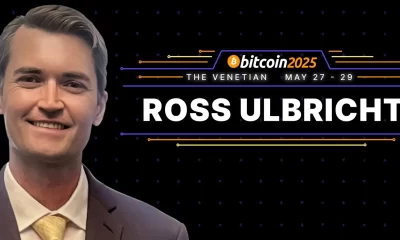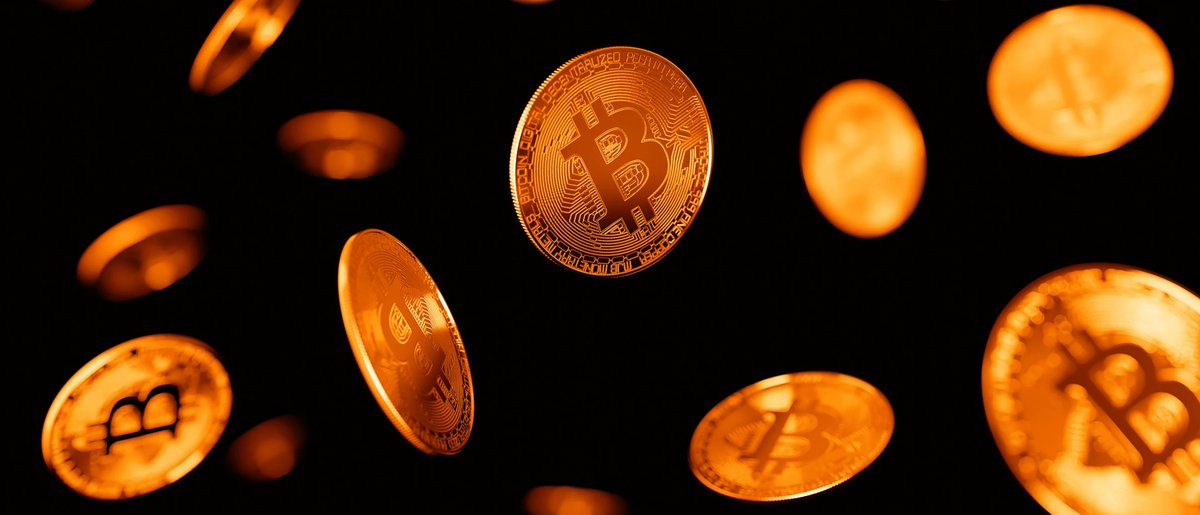Bitcoin
Swiss National Bank President Dismisses BTC as Reserve Asset
Published
1 month agoon
By
admin

Swiss National Bank (SNB) President Martin Schlegel has rejected the idea of holding bitcoin as part of Switzerland’s central bank reserves, citing a lack of stability, liquidity, and security, according to local media.
Speaking to the Tamedia group, Schlegel cited three primary concerns surrounding cryptocurrencies. The first one is their volatility, which he said makes them unsuitable for long-term value preservation.
“Second, our reserves need to be highly liquid so that they can be used quickly for monetary policy purposes if needed,” Schlegel told Tamedia before pointing to a lack of security inherent in being software-based assets. “We all know that software can have bugs and other weak points.”
The Swiss National Bank President’s words come amid a growing debate in Switzerland over the nascent asset class. A recent initiative is pushing for a constitutional amendment requiring the SNB to hold bitcoin in its reserves alongside gold, the article said.
The initiative, launched in December and led by entrepreneur Yves Bennaim, does not go into details when it comes to the bitcoin allocations but specifies it should be built up from the bank’s earnings. It has 18 months to collect 100,000 signatures in a bid to trigger a nationwide vote on the topic.
Despite Switzerland’s growing acceptance of cryptocurrencies, with various Swiss banks offering customers cryptocurrency-related services, Schlegel dismissed the asset class as a “niche phenomenon.” Currencies, he told Tamedia, have already been in competition, and Schlegel maintained the bank is “not afraid of competition from cryptocurrencies,” citing the continued strength of the Swiss franc.
Source link
You may like


CryptoPunks NFT Sells for $6 Million in Ethereum—At a $10 Million Loss


SEC drops suit against Helium for alleged securities violations


Tokenized Gold Nears $2B Market Cap as Tariff Fears Spark Safe Haven Trade


Ross Ulbricht To Speak At Bitcoin 2025


Solana Eyes $200 Target As It Gains Momentum – Recovery Could Mirror 3-Month Downtrend


BTC-denominated insurance firm meanwhile secures $40m in VC funding
analysts
Tariffs, Trade Tensions May Be Positive for Bitcoin (BTC) Adoption in Medium Term: Grayscale
Published
11 hours agoon
April 10, 2025By
admin

Tariffs and trade tensions could ultimately be positive for bitcoin (BTC) adoption in the medium term, asset manager Grayscale said in a research report Wednesday.
Higher tariffs result in stagflation— stagnant economic growth coupled with inflation — which is negative for traditional assets, but positive for scarce commodities such as gold, the report said.
Bitcoin is considered hard money, akin to digital gold, and is viewed as a modern store of value, the report noted.
Cryptocurrencies surged on Wednesday following President Donald Trump’s announcement of a 90-day pause on tariffs for countries that haven’t retaliated against the U.S.
“Trade tensions may put pressure on reserve demand for the U.S. Dollar, opening space for competing assets, including other fiat currencies, gold, and bitcoin,” Grayscale said.
Historical precedent suggests that dollar weakness and above-average inflation may persist, and bitcoin is likely to benefit from such a macro backdrop, the asset manager said.
“A rapidly improving market structure, supported by U.S. government policy changes” could help broaden bitcoin’s investor base, the report added.
Read more: Trump Administration Wants Weaker Dollar and That’s Positive for Bitcoin: Bitwise
Source link
Bitcoin
Jack Dorsey’s Block Launches Open Source Tools To Simplify Bitcoin Treasury Management
Published
1 day agoon
April 9, 2025By
admin
Block announced it has released a new open source toolkit designed to help companies manage their Bitcoin treasury holdings more efficiently. The release includes a corporate Bitcoin holdings dashboard and a BTC-to-USD real-time price quote API, now available for all companies and developers via Block’s public GitHub repository under the Block Open Source initiative.
As Bitcoin adoption grows among institutional treasuries, businesses are seeking better tools to track and report their holdings. Block’s new dashboard directly addresses these needs, offering real-time visibility, simplicity, and adaptability.
The dashboard aims to help companies monitor the dollar value of their Bitcoin holdings through a user-friendly interface designed for both finance teams and executives. It integrates real-time pricing data via an open source BTC/USD quote API, with future plans for quarter-end historical lookup features to support financial reporting. Block has invited feedback and feature requests from the open source community via GitHub Issues.
Block further highlighted that companies are increasingly turning to Bitcoin for a variety of strategic reasons:
- Diversification: Adding Bitcoin alongside traditional treasury assets.
- Ecosystem support: Demonstrating alignment with Bitcoin innovation, particularly for crypto-forward businesses.
- Inflation hedge: Serving as a store of value in the face of fiat currency devaluation.
- Portfolio optimization: Aiming to enhance risk-adjusted returns.
The first working prototype of the dashboard was created by non-engineers using Block’s internal open source AI agent, called codename goose. The AI agent enabled non-technical teams to prototype tools rapidly, with engineers from Block’s Bitcoin Platform team joining later to finalize development. Codename goose also contributed to front-end development via automated coding assistance.
Block has long been a corporate leader in Bitcoin investment. Its Bitcoin Investment Memo from October 2020 and its Bitcoin Blueprint for Corporate Balance Sheets laid the foundation for businesses entering the crypto space. Block said it continues to purchase Bitcoin through a monthly dollar-cost averaging (DCA) program and updates its dashboard quarterly after earnings reports. Its live Bitcoin treasury dashboard can be viewed here.
With this release, Block emphasized that it aims to empower other companies to manage Bitcoin on their balance sheets more confidently and transparently, further accelerating mainstream adoption of the world’s leading digital asset.
Source link
Altcoin
Why Isn’t XRP Skyrocketing? Expert Explains The Hidden Forces
Published
1 day agoon
April 9, 2025By
adminXRP prices dipped below $2 for the first time since December 2024 on Monday, even after a number of positive developments for the cryptocurrency.
The decline is surprising to many investors who had hoped recent good news would send its value higher. Market analyst Vincent Van Code attributes this underperformance to underlying economic issues and not with XRP itself.
Trump Tariffs Are Blamed For Crypto Market Decline
Van Code attributes the recent decline in cryptocurrencies to the tariffs imposed by US President Donald Trump on other nations.
The tariff situation is just a power play to utilize economic pressure to get better negotiating terms, said Van Code. He expects these trade tensions to be short-term and perhaps pave the way for the market to rebound in the near future.
Current #XRP prices are not aligned with recent @Ripple market announcenets, SEC case conclusion news, XRP US stockpile.
Do you think this is becuase XRP is not performing well?
I DONT! This is a global market downturn. Impacts across multiple markets, multiple countries, and…
— Vincent Van Code (@vincent_vancode) April 9, 2025
XRP Fundamentals Strong
Even after falling to $1.64 on April 7, XRP has shown a rebound by increasing to $1.82—a 10% increase. Van Code pointed out that Ripple and XRP’s fundamental strengths have not changed. They’re a hundred times better than a year ago when the SEC lawsuit was at its peak, he said.
The SEC-Ripple case resolution, potential inclusion in US digital asset reserves, and Ripple’s Hidden Road acquisition were all considered positive developments for the cryptocurrency.
Investment Strategy During Market Uncertainty
Van Code described his approach to today’s market condition, showing he buys such assets like XRP when sentiment is low but fundamentals remain in place.
He looks at weekly charts for larger decisions and uses hourly charts for intraday action. The market commentator termed XRP the “Fight Club” of cryptos because of its ability to withstand market action and stress.
Future Growth Drivers For XRP
Going forward, Van Code identified three key drivers to XRP adoption: regulation, corporate usage, and solid partnerships. He warned investors to avoid being influenced by short-term price fluctuations due to outside influences such as the tariff scenario.
The analyst said that he would only be jittery if XRP was the sole cryptocurrency that is dropping in value. He also stated that the current decline is part of a larger market trend and not particular to XRP.
The cryptocurrency market still responds to economic policy as investors look for indications that the tariff issue is resolved. Most XRP supporters are optimistic that as soon as these external pressures are gone, the price will more accurately reflect the good news surrounding Ripple and its currency.
Featured image from Unsplash, chart from TradingView
Source link

CryptoPunks NFT Sells for $6 Million in Ethereum—At a $10 Million Loss

SEC drops suit against Helium for alleged securities violations

Tokenized Gold Nears $2B Market Cap as Tariff Fears Spark Safe Haven Trade

Ross Ulbricht To Speak At Bitcoin 2025

Solana Eyes $200 Target As It Gains Momentum – Recovery Could Mirror 3-Month Downtrend

BTC-denominated insurance firm meanwhile secures $40m in VC funding

‘You Want To Own the Most Hated Thing’ – Arthur Hayes Says Ethereum Set To Outrun Solana As Memecoin Craze Fades

Crypto Braces for a Hidden $4.5 Trillion Catalyst for Bitcoin, Ethereum, Cardano, XRP Price

Block Agrees to $40M NYDFS Penalty Over Lackluster Compliance Program

Top Bitcoin miners produced nearly $800M of BTC in Q1 2025

Tariffs, Trade Tensions May Be Positive for Bitcoin (BTC) Adoption in Medium Term: Grayscale

The U.S. Tariff War With China Is Good For Bitcoin Mining

Dogecoin Bull Div Plays Out, Analyst Maps Next Price Targets

Web3 search engine can reshape the internet’s future

Billionaire Ray Dalio Says He’s ‘Very Concerned’ About Trump Tariffs, Predicts Worldwide Economic Slowdown

Arthur Hayes, Murad’s Prediction For Meme Coins, AI & DeFi Coins For 2025

Expert Sees Bitcoin Dipping To $50K While Bullish Signs Persist

Aptos Leverages Chainlink To Enhance Scalability and Data Access

Bitcoin Could Rally to $80,000 on the Eve of US Elections

Crypto’s Big Trump Gamble Is Risky

Sonic Now ‘Golden Standard’ of Layer-2s After Scaling Transactions to 16,000+ per Second, Says Andre Cronje

Institutional Investors Go All In on Crypto as 57% Plan to Boost Allocations as Bull Run Heats Up, Sygnum Survey Reveals

Ripple-SEC Case Ends, But These 3 Rivals Could Jump 500x

Has The Bitcoin Price Already Peaked?

A16z-backed Espresso announces mainnet launch of core product

The Future of Bitcoin: Scaling, Institutional Adoption, and Strategic Reserves with Rich Rines

Xmas Altcoin Rally Insights by BNM Agent I

Blockchain groups challenge new broker reporting rule

I’m Grateful for Trump’s Embrace of Bitcoin

Trump’s Coin Is About As Revolutionary As OneCoin
Trending

 24/7 Cryptocurrency News5 months ago
24/7 Cryptocurrency News5 months agoArthur Hayes, Murad’s Prediction For Meme Coins, AI & DeFi Coins For 2025

 Bitcoin3 months ago
Bitcoin3 months agoExpert Sees Bitcoin Dipping To $50K While Bullish Signs Persist

 24/7 Cryptocurrency News3 months ago
24/7 Cryptocurrency News3 months agoAptos Leverages Chainlink To Enhance Scalability and Data Access

 Bitcoin5 months ago
Bitcoin5 months agoBitcoin Could Rally to $80,000 on the Eve of US Elections

 Opinion5 months ago
Opinion5 months agoCrypto’s Big Trump Gamble Is Risky

 Altcoins2 months ago
Altcoins2 months agoSonic Now ‘Golden Standard’ of Layer-2s After Scaling Transactions to 16,000+ per Second, Says Andre Cronje

 Bitcoin5 months ago
Bitcoin5 months agoInstitutional Investors Go All In on Crypto as 57% Plan to Boost Allocations as Bull Run Heats Up, Sygnum Survey Reveals

 Price analysis5 months ago
Price analysis5 months agoRipple-SEC Case Ends, But These 3 Rivals Could Jump 500x


